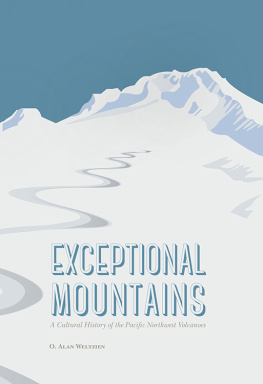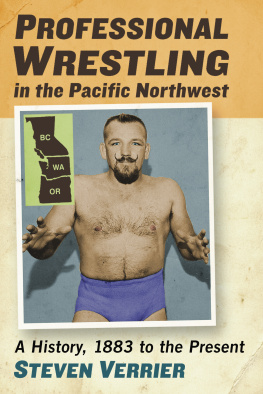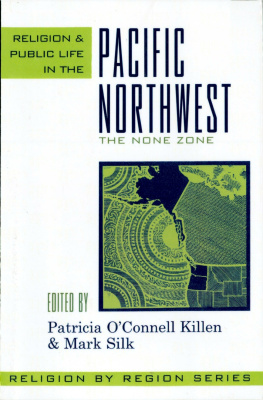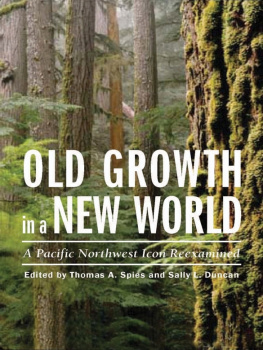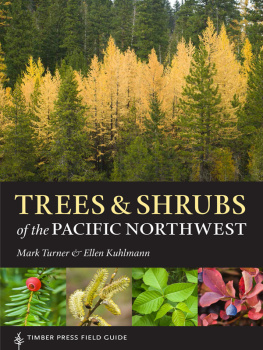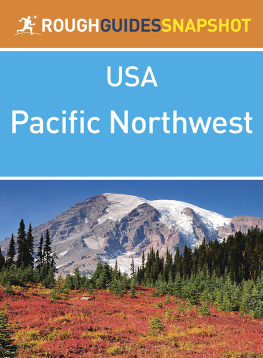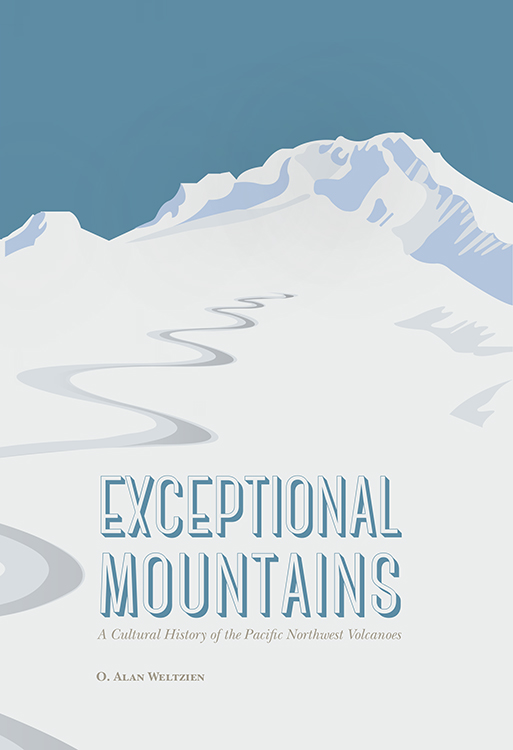Part environmental humanities treatise and part memoir, Weltziens study illuminates the cultural meaning of mountain wilderness.
Open[s] up new approaches to mountain literature, where historical, environmental, commercial, and literary viewpoints make clearer why and how we have sanctified these high-altitude monuments. You wont hike or look at these mountains again in the same way after reading this remarkable book.
To live under the volcano with Weltzien is to hike, sometimes anxiously, through fields of sociology, tourism, urban planning, and ecologythen to pause to contemplate lava domes, landscape painting, and indoor climbing walls. A book to engage both climbers and watchers.
Exceptional Mountains
A Cultural History of the Pacific Northwest Volcanoes
O. Alan Weltzien
University of Nebraska Press | Lincoln & London
2016 by the Board of Regents of the University of Nebraska
Cover designed by Rachel Gould
Author photo courtesy of author
All rights reserved
Library of Congress Cataloging-in-Publication Data
Names: Weltzien, O. Alan (Oliver Alan)
Title: Exceptional mountains: a cultural history of the Pacific Northwest volcanoes / O. Alan Weltzien.
Description: Lincoln: University of Nebraska Press, 2016.Includes bibliographical references and index.
Identifiers: LCCN 2015047730
ISBN 9780803265479 (hardback: alkaline paper)
ISBN 9780803290402 (epub)
ISBN 9780803290419 (mobi)
ISBN 9780803290426 (pdf)
Subjects: LCSH : Northwest, PacificGeography.Northwest, PacificEnvironmental conditions. VolcanoesSocial aspectsNorthwest, PacificHistory. MountainsSocial aspectsNorthwest, PacificHistory. RegionalismNorthwest, PacificHistory. | Outdoor recreationEnvironmental aspectsNorthwest, PacificHistory. | MountaineeringEnvironmental aspectsNorthwest, PacificHistory. | ConsumersNorthwest, PacificPsychologyHistory. | NatureEffect of human beings onNorthwest, PacificHistory. | Environmental policyNorthwest, PacificHistory. | BISAC : HISTORY / United States / State & Local / Pacific Northwest ( OR WA ). NATURE / Ecosystems & Habitats / Mountains. SPORTS & RECREATION / Mountaineering.
Classification: LCC F 852.3 . W 39 2016 | DDC 917.95dc23 LC record available at http://lccn.loc.gov/2015047730
The publisher does not have any control over and does not assume any responsibility for author or third-party websites or their content.
To Two Bills
William L. Lang, extraordinary editor
and
William E. Neighbor Jr., lifelong friend
at many altitudes
The Snowpeaks
Long stately procession,
snow pearls rise
north-south pendant, tiny
arc in the girdling
Pacific rim fire.
Though some point
like Mt. Hood and
Jefferson, more bulge,
domes curve
above serrated peaks.
Tahoma and Shasta
spread gigantic glacial skirts
far above forested ridges
above us.
Snyder says, West coast
snowpeaks are too
[fucking] much!
They defy knowledge,
spurn our yearning for
contact, lure us with
boots crampons ropes,
cameras brushes and pen.
Braided by glaciers, they
mask fiery throats,
steam below snow,
their sleep temporary:
St. Helens blowing
her head off one May
morning, 1980.
Volcanoes awaken our
desire as we trace
their curves,
stretch our gaze
of ourselves.
Shining horizon anchors often
cloaked behind thick grey
curtains, they exist apart
we so want
to be
part of them.
O. Alan Weltzien, from The Snowpeaks
Contents
This book grew slowly and, at times, painfully. It originated decades ago when I lived in Puget Sound and hiked, whenever possible, in the Cascades, my first mountain range. I studied Mount Baker during Camano Island summers and Mount Rainier, the other seasons. Later I came to know Washingtons Glacier Peak, Mount St. Helens, and Mount Adams, several among Oregons multitude, and Californias Lassen Peak and Mount Shasta.
My climbs precipitated other, more sustained inquiries into the Northwests volcanoes. I wanted to know everything about them, particularly as the human footprint on and around them accelerated. I began reading the remarkable Weyerhaeuser environmental history series published by the University of Washington Press. Later I pitched this book idea to William L. Lang, a distinguished Northwest historian, for a small series he edited. Though the series has languished, Lang proved an able mentor, editor, and friend, and the dedication reflects, at least in part, my gratitude.
This book would never have blossomed without interlibrary loan, and in that capacity I want to thank Denise Rust, of the University of Montana Westerns Lucy Carson Library, for her reliable help. Among my Montana Western colleagues I particularly thank Steve Mock, gifted mountaineer and teacher who taught me rock climbing and who, in June 1993 led two friends and me up the Emmons-Winthrop route on Mount Rainier. That climb yielded a personal essay, On Tahoma (The Climbing Art, 1995), and it and other volcano climbs led eventually to this book.
Friends too many to name in my three primary professional organizationsthe Western Literature Association ( WLA ), the Association for the Study of Literature and Environment ( ASLE ), and the Pacific Northwest American Studies Association ( PNASA )have expressed steady interest and support over the years. They have tolerated my obsession with the Northwest volcanoes. I would single out Paul Lindholdt, of Eastern Washington University, who introduced me into PNASA and who more than matches my interests in Pacific Northwest Studies, ecocriticism, and bioregionalism.
I would also thank the anonymous readers at more than one university press, each of whom challenged me to clarify my lines or argument and ranges of reference. I particularly thank Bridget Barry, of the UNP , for believing in this book and signing me to Nebraska, where I join many WLA and ASLE friends as authors.
Finally, I thank my late mother, Lorraine B. Weltzien, who for decades sent me a steady stream of news clippings about Rainier and other mountains, and who accepted my obsession, though she never understood it. I also thank my two friends from early childhood, Galen P. Stark and Bill Neighbor, with whom I climbed Mount Baker more than twenty years ago. Bills role in my life is reflected, in part, in the dedication. Galen, retired career NPS employee who worked in both Mount Rainier National Park and North Cascades National Park, loves the Cascades, particularly Rainier, at least as much as I do. For many years we have hiked together, scrambling above tree line.
In addition I thank my familystepdaughter Melinda, and sons Alec and Joelfor their support and especially my wife, Lynn M. Weltzien. Like my late mother, she does not enjoy hiking in the mountains. But she has let me indulge myself every summer, and has proven a sturdy sounding board and advocate as this book unfolded. Her support of my writing is unwavering.
Any errors in fact or interpretation remain my own.

